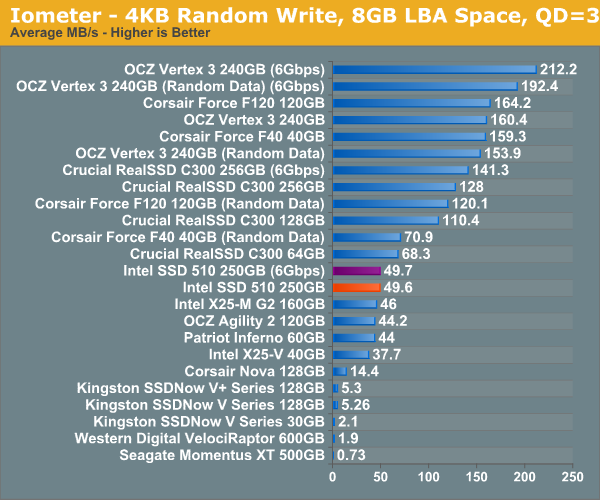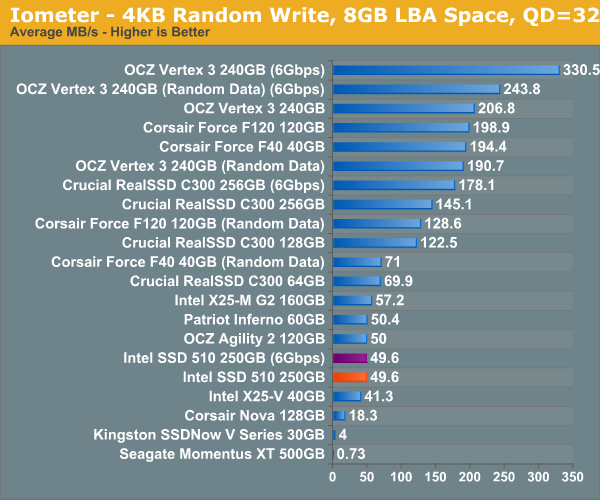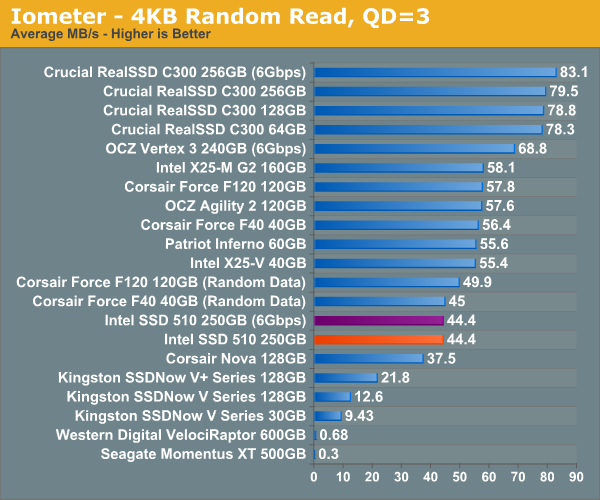The Intel SSD 510 Review
by Anand Lal Shimpi on March 2, 2011 1:23 AM EST- Posted in
- IT Computing
- Storage
- SSDs
- Intel
- Intel SSD 510
Random Read/Write Speed
The four corners of SSD performance are as follows: random read, random write, sequential read and sequential write speed. Random accesses are generally small in size, while sequential accesses tend to be larger and thus we have the four Iometer tests we use in all of our reviews.
Our first test writes 4KB in a completely random pattern over an 8GB space of the drive to simulate the sort of random access that you'd see on an OS drive (even this is more stressful than a normal desktop user would see). I perform three concurrent IOs and run the test for 3 minutes. The results reported are in average MB/s over the entire time. We use both standard pseudo randomly generated data for each write as well as fully random data to show you both the maximum and minimum performance offered by SandForce based drives in these tests. The average performance of SF drives will likely be somewhere in between the two values for each drive you see in the graphs. For an understanding of why this matters, read our original SandForce article.

It's a bit unfortunate for Intel that we happen to start our performance analysis with a 4KB random write test in Iometer. The 510's random write performance is only marginally better than the X25-M G2 at 49.7MB/s. The RealSSD C300 is faster, not to mention the SF-1200 based Corsair Force F120 and the SF-2200 based OCZ Vertex 3.
Although not depicted here, max write latency is significantly reduced compared to the X25-M G2. While the G2 would occasionally hit a ~900ms write operation, the 510 keeps the worst case latency to below 400ms. The Vertex 3 by comparison has a max write latency of anywhere from 60ms - 350ms depending on the type of data being written.
Many of you have asked for random write performance at higher queue depths. What I have below is our 4KB random write test performed at a queue depth of 32 instead of 3. While the vast majority of desktop usage models experience queue depths of 0 - 5, higher depths are possible in heavy I/O (and multi-user) workloads:

While the X25-M G2 scaled with queue depth in our random write test, the 510 does not. It looks like 50MB/s is the absolute highest performance we'll see for constrained 4KB random writes. Note that these numbers are for 4KB aligned transfers, performance actually drops down to ~40MB/s if you perform sector aligned transfers (e.g. performance under Windows XP).

Random read performance is just as disappointing. The X25-M G2 took random read performance seriously but the 510 is less than 20% faster than the Indilinx based Corsair Nova. When I said the Intel SSD 510's random performance is decidedly last-generation, I meant it.










128 Comments
View All Comments
Golgatha - Wednesday, March 2, 2011 - link
I'd also like to add that you will however most certainly notice the difference of 3.15MB/s of random R/W performance my RAID0 Velociraptors put out versus the random R/W performance of pretty much any SSD. SSDs make a huge amount of sense as an OS and applications drive.
EddyKilowatt - Wednesday, March 2, 2011 - link
"...the last thing SSDs are lacking is speed..."Amen. Ninety percent of us still have 3 GB SATA and are just waiting for the 25 nm devices to do their thing to the $/GB on more prosaic drives
mgl888 - Wednesday, March 2, 2011 - link
I had high expectations from Intel.. now I'm a little disappointed.As the article said, random read is MOST important for a boot drive. Surely Intel should know this?
critical_ - Wednesday, March 2, 2011 - link
I'm not sure I agree.1. The SSD market still has a lot of growth ahead of it. Price per GB is the current issue and may be the new "performance per watt" buzz word in this space. Case in point, when I can grab a cheap Dell server for $350 and average notebooks are advertised everyday for $300-$600, are people really going to spend $300-$600+ on an SSD? If it was a much cheaper option then many would go with it.
2. Synthetic vs. Real-world. Synthetic benchmarks are great for bragging on the various overclocking forums but most of us get work done in the real-world. This is no different than people who tune cars for 1/4 mile races but must transport the car on a flat-bed carrier. For some this is a perfectly great trade-off for bragging rights but many of us prefer to get 90% of the 1/4 mile performance and be able to drive the car back and forth to a weekend outing. My point is that in real-world benchmarks there may be some minor deficiencies but will 95% of users notice? I doubt it.
3. I put an Intel X-25M G2 160GB SSD in my father's quad-core desktop that he uses for Photoshop work after listening to many months of complaints that his system was too slow. After the swap, he loves the performance and I love the fact that I'm no longer fielding "it's too slow" complaints. This was the best money I've spent in recent memory but the price is still an issue for most people.
4. Would a user like my father noticed a difference between the X-25M and either a 510 or Vertex 3? I doubt it. Besides we'd have to get him a SATA3 motherboard or an add-in card. Again, it's a price issue.
5. Not too long ago the must-have upgrade was adding RAM to a Windows machine. These days 3-8GB systems are almost the norm so the must-have upgrade is an SSD if a user can stomach the cost. Head on over to NewEgg and read the reviews of "value" SSDs and you'll get an idea of the disappointment for some people who transitioned from HDDs to SSDs in both desktops and laptops. The drives in this segment aren't changing the user experience as dramatically as those ponying up for the high-end devices. Then there is the issue of lack of TRIM support, 4K issues, firmware upgrades destroying data, and the list goes on. The segment needs to addressed by Intel.
6. Finally, hybrids. We see the Intel Z68 will support SSD caching along with higher-end stuff from Adaptec or HighPoint's RocketHybrid controllers trying to get the best of both SSDs and HDDs. Could this be a game-changer? Possibly.
The points that I'm making come down to both real-world performance and market segments. The SSD market would benefit from a better stragety on the entry-level and mid-range markets the way ATI and nVidia have done things. Whoever brings the price down to grab the majority of users will eventually win a good chunk of business. With all that aside, as it stands the 510 is fine for the types of loads I'd put on an SSD as a power user so I'm happy to trade a bit of real-world performance for Intel's reliability.
landerf - Wednesday, March 2, 2011 - link
Well that was disappointing. Unless intel prices themselves under OCZ they may do very poorly with this drive.semo - Wednesday, March 2, 2011 - link
The sad thing is that they won't. They always have their "conroe" moment and then they sink up their product in the next generations but they still come out ahead. Even their Prescott cores did very well when they shouldn't have.vol7ron - Wednesday, March 2, 2011 - link
Yeah that was my fault. I shouldn't have bought a Prescottm.amitava - Wednesday, March 2, 2011 - link
I am really the biggest fan of Anand and his team (used to bypass my company firewall and risk losing my job just to read all the stuff here..) but it does seem like Anand is trying to smooth over the 510's seriously non-competitive random performance....IMO it showed badly enough that I finally decided to sign up and post a comment...
I hope I am mistaken...
Sigwulff - Wednesday, March 2, 2011 - link
Well isn't it the old debate regarding synthetic vs. real-world tests? I'll admit it looked bleak for the random parts, but looking at the heavy and light workload 510 looked somewhat shinier...I was 100% sure on the Vertex 3, but presently I'll have to wait and see about the pricing when it lands here in little Denmark :-)
Btw, mentioning the bundle you completely overlooked the very nice cabinet sticker Intel included. I would like some tests about glue adherency, how envious your friends look when they see the sticker on your pc-cabinet etc. :-)
ok just kidding, very nice and informative review! (why we love Anand so much :-)
semo - Wednesday, March 2, 2011 - link
+1I'm still disappointed that Anand hasn't covered the OCZ Vertex 2 "25nm version" con. This is a consumer rights issue and should take precedence over any other development of a technical nature.